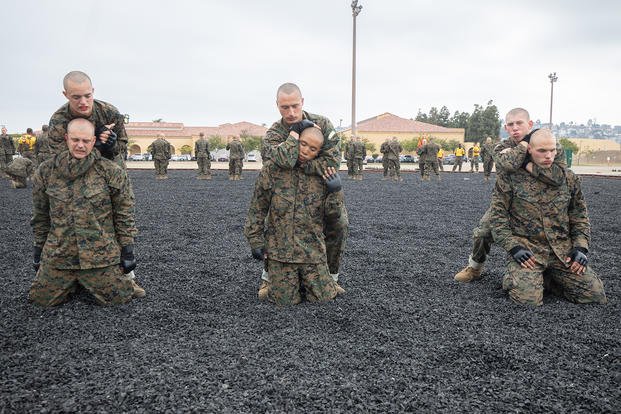Days after Jordan Neely died after being held in a chokehold by a Marine veteran aboard a New York City subway train, the vet has identified himself amid swirling questions about the use of the tactic, which is taught in basic training by the service.
Twenty-four-year-old Daniel Penny identified himself in a statement from his lawyers as the Marine who was seen on video using a chokehold on Neely for minutes until he stopped moving.
Late on Friday, lawyers Steven Raiser and Thomas Kenniff released a statement confirming that they represented Penny and that he was, in fact, "involved in a tragic incident on the [New York City] subway, which ended in the death of Jordan Neely."
Read Next: Fort Hood Gets a New Name Honoring a Texas-Born Four-Star General
The statement goes on to argue that Penny "never intended to harm Mr. Neely and could not have foreseen his untimely death."
According to records released by the Marine Corps last week, Penny served a single tour -- from 2017 to 2021 -- as a rifleman Marine. His last duty station was 1st Battalion, 2nd Marines, and he did one deployment to the Mediterranean with the 22nd Marine Expeditionary Unit (MEU) in 2019. He left as a corporal but was promoted to sergeant while in the Individual Ready Reserve.
Now other Marines are questioning Penny's actions, and one has started a petition calling for his prosecution, arguing Penny did not act in accordance with the training Marines receive.
Gabriel Murphy, a fellow Marine veteran who had a remarkably similar career to Penny, served one tour in the Corps from 2006 to 2010 as an assaultman Marine with 1st Battalion, 5th Marines, where he deployed with the 11th MEU in 2007 and to Afghanistan in 2009. He also ended up leaving the service as a corporal.
Last week, Murphy started an online petition that argued that "the individual who choked Mr. Neely to death should be prosecuted for murder." The petition had been signed by nearly 6,000 people as of Tuesday afternoon.
"I hope that the military community joins me in disavowing the actions of this individual," it added.
In an interview with Military.com, Murphy said that training on chokeholds is "not something you touch once in boot camp and then go forget about."
Both Murphy and Penny received instruction on the Marines' version of martial arts -- the Marine Corps Martial Arts Program (MCMAP) -- starting in boot camp. The official website of Marine Corps Recruit Depot Parris Island notes that the Corps' graduation requirements include that "all recruits undergo training in the Marine Corps Martial Arts Program throughout training" and adds that "they earn a tan belt, the entry-level belt of the five-level system."
According to the document that lays out the standards for the program, part of the tan belt curriculum includes training on performing a rear choke, in addition to a variety of strikes, counters and other takedown techniques.
"I can tell you just living at the barracks, or being on a MEU, or just existing in 1/5 -- we did some of that stuff constantly and a lot of it was informal," Murphy explained, while adding that MCMAP training is not designed to be non-lethal or safe.
Murphy, whose unit and Afghanistan deployment were profiled in the documentary "Patrol Base Jaker", said that the Marines teach close combat techniques only in the frame of repelling the enemy's assault -- and even then "those [techniques] are all taught, essentially, as 'you screwed up and now somebody's grappling with you.'"
"You're basically starting to kill them, and then you have to decide when to stop," Murphy said.
Military.com reached out to the Marine Corps several times for this story with questions about training chokeholds, but with the exception of providing Penny's record -- a move it noted was not meant to confirm any detail of the video shot on the subway or that Penny was the person involved, the service has not spoken about the incident.
A Marine Corps spokesman said the service is staying silent so that it would be in compliance with the Privacy Act.
The Department of Justice has banned the use of chokeholds by federal law enforcement agencies since 2021, except when deadly force is authorized, because they have "too often led to tragedy."
"These techniques are inherently dangerous," the department wrote in a memo dated September 2021.
The Marine Corps' MCMAP manual says that "when executed properly, a blood choke takes between 8 to 13 seconds for the aggressor to lose consciousness."
CNN reported that a witness said the two men were on the floor for about seven minutes.
The use of neck holds that restrict either air or blood to the brain have a long and tragic history, including the killing of Eric Garner by New York City Police in 2014. There are myriad other examples of suspects dying after chokeholds just in the last several decades alone.
Kenniff, one of the two lawyers who signed Penny's statement, ran against Alvin Bragg, the man who is now charged with making the decision on whether to prosecute Penny, in the 2021 election.
Murphy doesn't want Penny's actions to further color the view that the public has of his fellow Marines and veterans.
"This is not representative, and I'm trying to get that out there," he said, before adding that "veterans have enough problems without [being associated with Penny's actions]."
-- Konstantin Toropin can be reached at konstantin.toropin@military.com. Follow him on Twitter @ktoropin.
Related: Marines Look to Get Closer to Special Operations Teams While Practicing Extractions













